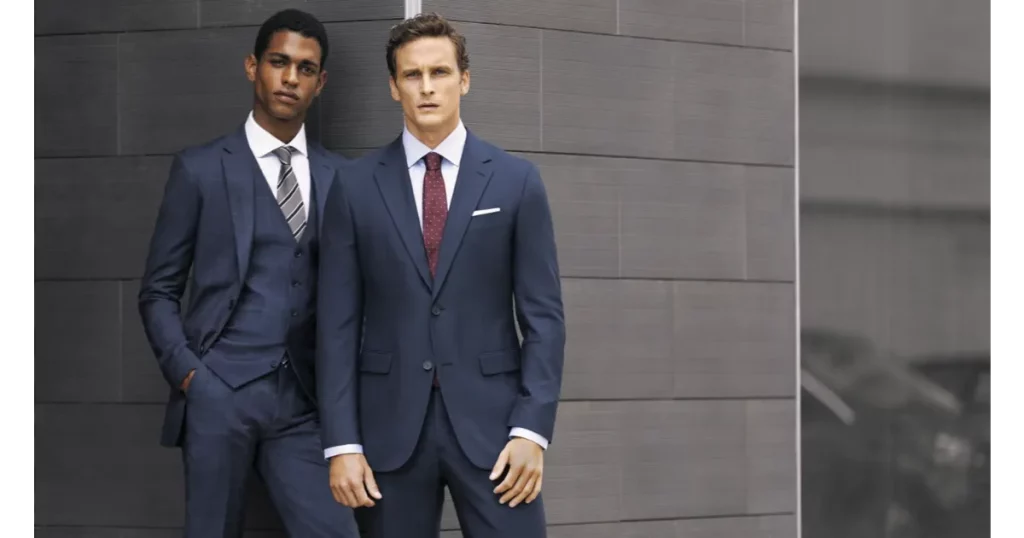No products in the cart.
Blog
Suit Sleeve Length: Nailing The Fit For A Sharp Look
When it comes to creating a polished, professional image, every detail matters – including the length of your suit sleeve. A perfectly tailored suit sleeve can significantly boost your overall look, showcasing a sense of style that is both refined and sophisticated.
Getting this detail right, however, is more complex than it appears. In this blog post, we’ll delve into the art of nailing suit sleeve length, helping you to achieve that sharp, put-together look that leaves a lasting impression.
Below is a simple table about suit sleeve lengths. These measurements are typically taken from the shoulder seam to the end of the sleeve.
| Size | Sleeve Length (in inches) |
|---|---|
| Short | 23 – 24 |
| Regular | 24 – 25 |
| Long | 25 – 26 |
| Extra Long | 26 and above |
Understanding the Importance of Suit Sleeve Length

Understanding the importance of suit sleeve length extends beyond just aesthetics. It’s about communicating professionalism, attention to detail, and personal style. A well-fitted suit sleeve does more than just sit comfortably on your wrist. It frames your shirt’s cuff, adds depth to the suit’s silhouette, and can even impact how your hands and gestures are perceived.
The length of your suit sleeve can subtly alter how others perceive you, making you appear more competent and confident in professional settings, or more stylish and tasteful in social situations. A too-short sleeve can make the suit appear ill-fitting and cheap, while a too-long sleeve can look sloppy and careless.
In essence, understanding the importance of suit sleeve length is about understanding that a well-fitted suit is a sum of its parts, each contributing to the overall image of sophistication and style. Achieving the perfect suit sleeve length is a critical step towards nailing that image.
The Basics of Suit Sleeve Length
When talking about the basics of suit sleeve length, there are a few key principles to keep in mind. The standard rule is that your suit sleeve should end right above the hinge of your wrist, allowing for about a quarter to half an inch of your shirt cuff to show. This balance provides a harmonious transition from suit to shirt, adding a touch of elegance to your overall appearance.
However, personal preference and current fashion trends can also influence suit sleeve length. Some might prefer a slightly shorter sleeve to show off more shirt cuff, which can add a dash of color if you’re wearing a patterned or colored shirt. On the other hand, a longer sleeve might be chosen for a more traditional look.
Remember, the fit of your suit sleeve isn’t just about length. It should also be slim enough to follow the line of your arm without being too tight. A well-fitted suit sleeve will allow for natural movement while still maintaining its shape.
Finally, don’t forget the importance of professional tailoring when it comes to achieving the perfect suit sleeve length. No two bodies are the same, and what works off-the-rack might not be the best fit for you. Always consider seeking the help of a professional tailor to ensure your suit sleeve length is just right for your body type and personal style.
How to Measure Suit Sleeve Length Accurately
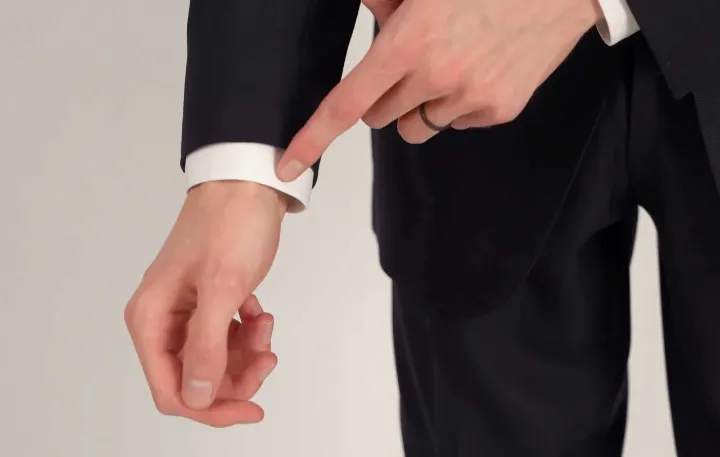
Measuring suit sleeve length accurately is crucial to get the perfect fit. The process might seem daunting initially, but with a little bit of patience and the right tools, anyone can do it successfully.
- Get Your Tools Ready: You’ll need a flexible measuring tape for this process. They are readily available at sewing stores or online.
- Find Your Starting Point: Start by finding the top of your shoulder, where the shoulder seam on a well-fitting shirt would lie. This is the point where your shoulder meets your arm.
- Measure Down to Your Wrist: Hold the tape at your starting point, and run it down the length of your arm. For an accurate reading, keep your arm slightly bent at a natural angle. The tape should go over your elbow and end at the point where your thumb joint meets your wrist.
- Jot Down Your Measurement: Look at the measuring tape and note down the measurement from your shoulder to your wrist. This is your suit sleeve length.
- Double Check: Repeat the process for your other arm. While most people have equal arm lengths, there might be slight variations.
| Size | Chest Measurement (in inches) | Chest Measurement (in centimeters) | Sleeve Length (in inches) | Sleeve Length (in centimeters) | Jacket Length (Regular) | Jacket Length (Long) | Jacket Length (Short) | Shoulder Width (in inches) | Shoulder Width (in centimeters) |
|---|---|---|---|---|---|---|---|---|---|
| 36 | 34 – 36 | 86 – 91 | 32 – 33 | 81 – 84 | 28 – 29 | 29.5 – 30.5 | 26.5 – 27.5 | 16.5 – 17 | 41.9 – 43.2 |
| 38 | 36 – 38 | 91 – 97 | 32 – 33 | 81 – 84 | 28 – 29 | 29.5 – 30.5 | 26.5 – 27.5 | 17 – 17.5 | 43.2 – 44.5 |
| 40 | 38 – 40 | 97 – 102 | 33 – 34 | 84 – 86 | 29 – 30 | 30.5 – 31.5 | 27 – 28 | 17.5 – 18 | 44.5 – 45.7 |
| 42 | 40 – 42 | 102 – 107 | 33 – 34 | 84 – 86 | 30 – 31 | 31.5 – 32.5 | 28 – 29 | 18 – 18.5 | 45.7 – 47 |
| 44 | 42 – 44 | 107 – 112 | 34 – 35 | 86 – 89 | 31 – 32 | 32.5 – 33.5 | 29 – 30 | 18.5 – 19 | 47 – 48.3 |
| 46 | 44 – 46 | 112 – 117 | 34 – 35 | 86 – 89 | 32 – 33 | 33.5 – 34.5 | 30 – 31 | 19 – 19.5 | 48.3 – 49.5 |
| 48 | 46 – 48 | 117 – 122 | 35 – 36 | 89 – 91 | 33 – 34 | 34.5 – 35.5 | 31 – 32 | 19.5 – 20 | 49.5 – 50.8 |
Column Descriptions:
- Chest Measurement: The range of chest sizes that typically correspond to each size.
- Sleeve Length: The recommended sleeve length for the specified size.
- Jacket Length (Regular/Long/Short): The length of the jacket for regular, long, and short sizes.
- Shoulder Width: The width of the shoulders for the specified size.
This table should give you a comprehensive overview of key measurements for different suit sizes, helping you choose the right fit based on your body proportions. Keep in mind that these measurements are general guidelines, and individual body shapes may vary.
The Relationship Between Suit Sleeve And Shirt Sleeve Lengths
The relationship between suit sleeve and shirt sleeve lengths is a delicate interplay that significantly impacts the overall sophistication of your style. The key concept behind this relationship lies in achieving an elegant balance where the shirt cuff extends slightly beyond the suit sleeve.
This balance typically means allowing about a quarter to half an inch of shirt cuff to show beyond the suit sleeve. This visible cuff length serves a practical purpose as it prevents the suit fabric from dirtying or wearing out due to frequent contact with hands or objects.
Moreover, the peek of the shirt cuff adds a touch of visual interest to the ensemble and provides an opportunity for an additional splash of color or pattern, particularly when wearing a cufflink or a stylish watch. The visible shirt cuff can also create an elongating effect making your arms appear longer and your overall look more streamlined.
It’s vital to note that the relationship between suit sleeve and shirt sleeve lengths is not a static one. Fashion trends fluctuate, and personal preferences vary, which can affect this balance. However, the enduring rule, regardless of changing trends, remains the same – your shirt cuff should always be visible beyond your suit sleeve. This hallmark of well-executed menswear style speaks volumes about your attention to detail and understanding of sartorial elegance.
Common Mistakes in Suit Sleeve Length Adjustment
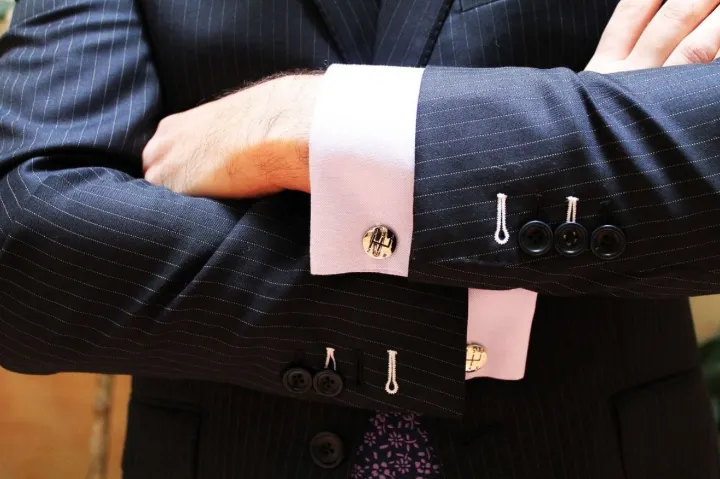
Going Too Short or Too Long
One of the most common mistakes in suit sleeve length adjustment is going too short or too long. A sleeve that’s too short can make you appear ill-fitted, while one that’s too long can make the suit look oversized and sloppy. Both extremes disrupt the harmony of your outfit and affect your overall appearance negatively.
Ignoring the Shirt Sleeve Length
Another common mistake is disregarding the length of your shirt sleeve when adjusting your suit sleeve length. As mentioned earlier, a well-fitted ensemble should allow for a quarter to half an inch of your shirt cuff to show. Ignoring this can lead to either too much shirt cuff showing or none at all, both of which are not desirable.
Neglecting Armhole Size
The armhole size is often overlooked when adjusting suit sleeve length. A high armhole allows for better arm movement and makes the suit look sleeker. On the other hand, a low armhole can cause the suit jacket to lift when you raise your arm, making it uncomfortable and visually unappealing.
Not Considering the Overall Fit
Many make the mistake of not considering the overall fit of the suit when adjusting the sleeve length. Even if the sleeve length is perfect, if the rest of the suit doesn’t fit well, it can throw off the entire look. It’s essential to ensure the suit jacket fits well in the shoulders, chest, and waist.
Skipping Professional Tailoring
Finally, many people skip professional tailoring, thinking they can make adjustments themselves. While minor adjustments might be manageable at home, it’s always best to get professional help, especially for significant changes. A professional tailor not only ensures accurate measurements but also provides advice based on your body type and personal style.
How to Tailor a Suit Sleeve for the Perfect Fit
Step 1: Gather the necessary equipment
Before you start tailoring your suit, gather all the necessary tools. This includes a sewing machine, pins, thread that matches your suit material, scissors, a tape measure, and an iron.
Step 2: Measure
With the suit on, measure the length you want the sleeve to be. An ideal length is where your hand connects to your wrist. Mark this spot with a pin.
Step 3: Pinning
Take off the suit and turn the sleeve inside out. Starting at the existing seam, pin the material evenly to the length you previously measured.
Step 4: Sewing
Using the sewing machine, carefully sew along the line of pins. Try to keep the line as straight as possible.
Step 5: Cutting
After sewing, cut the excess fabric, leaving about half an inch from the seam. Then, using an iron, press the remaining fabric flat against the sleeve.
Step 6: Finishing Touches
Turn the sleeve back to the right side and iron the end for a crisp, professional finish. Repeat the process for the other sleeve. Remember, practice makes perfect, so don’t be disheartened if you don’t get it right the first time.
Suit Sleeve Length and Different Body Types
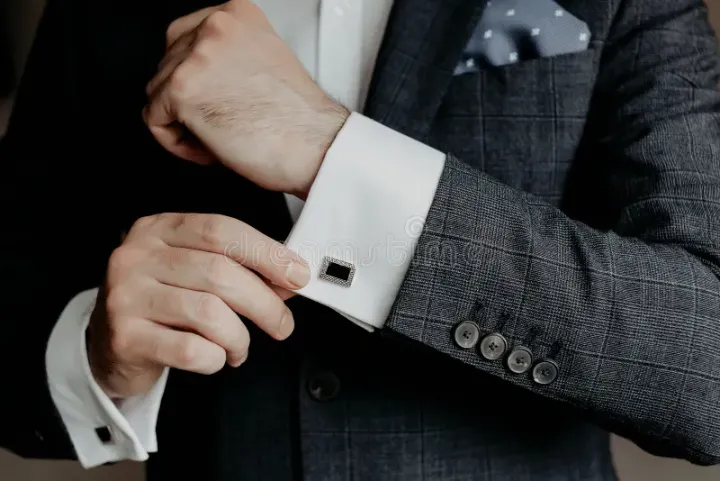
Understanding the relationship between suit sleeve length and different body types is crucial for achieving an impeccable fit. Different body types demand unique considerations in tailoring, and the sleeve length is no exception. From broad-shouldered individuals to those with a leaner frame, each body type has its unique nuances that should be accounted for while tailoring a suit sleeve.
- Tall and Slim: Individuals who are tall and slim often benefit from longer suit sleeves to complement their elongated limbs. The sleeve should end where the base of the thumb meets the wrist.
- Short and Stout: For individuals who are shorter and stouter, a slightly shorter sleeve length can provide the illusion of height, creating a more balanced appearance. The sleeve should end slightly above the wrist bone.
- Athletic Build: Those with an athletic build may require broader shoulder measurements with a tapering sleeve to highlight their muscular build. The sleeve length should ideally meet the wrist bone.
- Average Build: Individuals with an average build have the most flexibility when it comes to sleeve length. However, the classic rule of thumb is that the sleeve should end at the point where the hand connects with the wrist to provide the most tailored look.
- Petite: Petite individuals often benefit from a shorter sleeve length to balance their smaller stature. The sleeve should end slightly above the wrist bone for a more proportional look.
The Role of Fabric in Determining Suit Sleeve Length
The type of fabric used in a suit can significantly impact the sleeve length and overall fit. Different fabrics have varying levels of stretch, drape, and rigidity, all of which can affect how the sleeve hangs on the arm.
Thicker, heavier fabrics like wool or tweed have a rigid structure and less stretch. For these materials, the sleeve length should be long enough to allow movement without pulling at the shoulders. They require precise tailoring to ensure the sleeve doesn’t appear too bulky or stiff.
Lighter fabrics, such as silk or linen, have more drape and flexibility. These materials may require a slightly shorter sleeve length as the fabric is prone to move and flow more. Too much length may cause the sleeve to bunch up around the wrist.
Stretchy materials, like jersey or certain synthetics, can be more forgiving with sleeve length due to their stretch and recovery properties. However, care should still be taken not to make the sleeve too long to avoid a sloppy appearance.
Additionally, the fabric’s weight and texture can influence the perception of sleeve length. Heavier, textured fabrics can visually shorten the sleeve, while lighter, smoother fabrics can elongate the appearance. This optical illusion should be taken into account when determining the optimal sleeve length.
In conclusion, while body type and personal preference are significant factors in determining suit sleeve length, the role of fabric cannot be overstated. A good understanding of how different fabrics behave and affect sleeve length can help ensure a perfect, tailored fit.
Suit Sleeve Length: Expert Tips and Tricks
Achieving the perfect suit sleeve length can be a meticulous process, but the result is truly worth it. As you delve into the art of tailoring, it’s beneficial to have a set of expert tips and tricks up your sleeve. From understanding the nuances of body types, to mastering the subtleties of fabric choice, this section will provide you with key insights that professionals use in achieving that impeccable fit. Let’s explore these expert tips and tricks for mastering suit sleeve length.
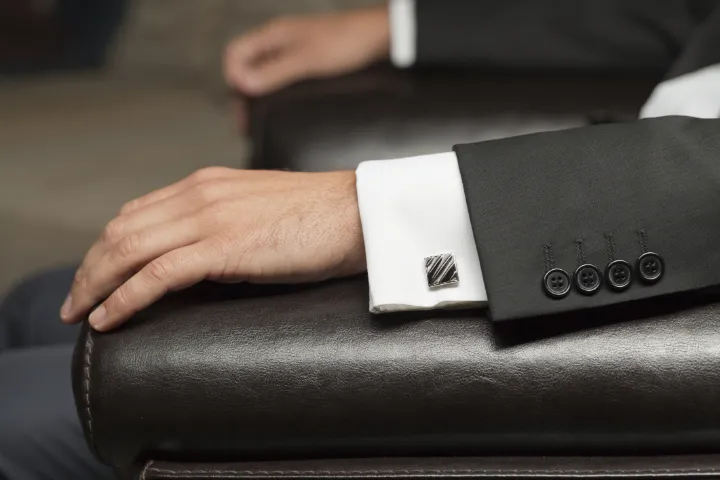
Always Prioritize Comfort
No matter how impeccable a suit may look, if the fit isn’t comfortable, it won’t serve its purpose. Always ensure that the suit’s sleeve length allows for unrestricted movement, making it comfortable to wear for extended periods.
Mind the Shirt Cuff
A well-fitted suit sleeve should reveal about half an inch of your shirt cuff. This detail subtly enhances the overall appearance and indicates that the suit is well-tailored to your measurements.
Remember, Alterations are Possible
Don’t be discouraged if you can’t find a suit with the perfect sleeve length off the rack. Remember, alterations are always an option. A skilled tailor can adjust the sleeve length to your exact specifications.
The Right Fit for Each Occasion
Different occasions might call for slight variations in sleeve length. For example, a more casual suit may have a slightly shorter sleeve length compared to a formal business suit. It’s important to keep the context in mind while tailoring or buying a suit.
The Importance of Symmetry
Ensure both sleeves are of the same length. This might seem obvious, but sometimes, especially in the case of alterations, slight discrepancies can occur. A symmetrical fit is key to a polished look.
Dealing with Suit Sleeve Length Discrepancies
Encountering discrepancies in your suit sleeve length can be quite a hassle but is an issue that can be addressed with the right guidance. Such discrepancies can occur for several reasons, including a lack of symmetry in arm length, inaccuracies during the tailoring process, or changes in your body size after the suit has been made.
Firstly, it’s important to identify the discrepancy. A mirror check will often suffice – simply extend your arms and see if the sleeves end at the same point. Another method is to feel where the sleeve ends with your opposite hand; if there’s a noticeable difference, then there’s a discrepancy.
Once a discrepancy has been identified, it’s time to consider your options. If the discrepancy is minor, say a quarter of an inch or less, it might not be noticeable, especially if the suit jacket is worn open. In such cases, you may choose to live with the discrepancy, as altering the sleeve length might not be worth the cost or effort.
However, if the discrepancy is significant and noticeable, it’s best to take the suit to a professional tailor. They can shorten an overly long sleeve or, in some cases, let out a sleeve that’s too short. Keep in mind that letting out a suit sleeve can only be done if there is extra fabric available inside the cuff. A good tailor will be able to advise you on the best course of action.
In the event that a sleeve cannot be lengthened, a possible workaround is to shorten the other sleeve to match. While not ideal, this ensures symmetry, which is a key aspect of a well-fitted suit.
When it comes to suit sleeve length discrepancies, being proactive is crucial. Regularly check your suits for fit and address any issues as soon as they arise. Remember, a well-fitted suit is not just about looking good; it’s about feeling confident and comfortable as well.
FAQs
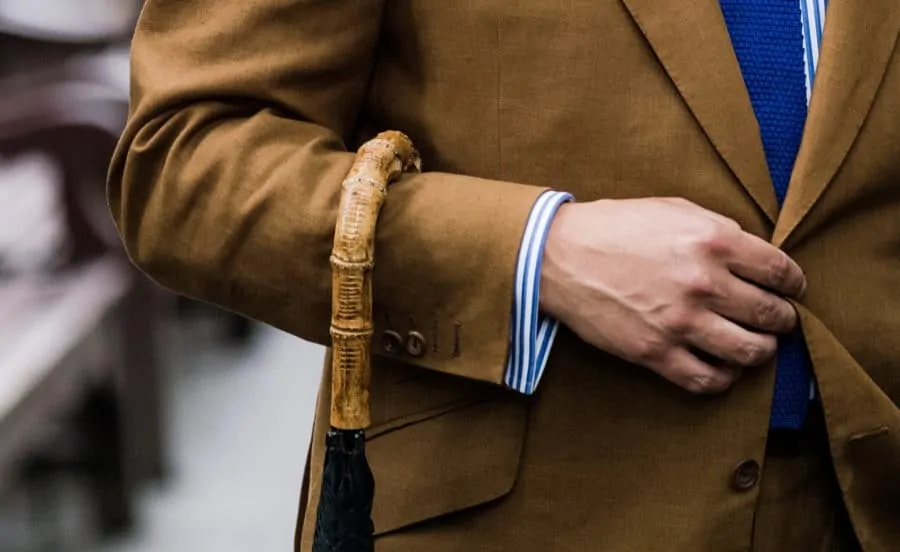
How do I know if my suit sleeve length is correct?
The perfect suit sleeve length typically falls where the base of your thumb meets your wrist. There should ideally be about a half-inch of your shirt cuff visible beyond the suit sleeve. However, factors such as personal preference and the style of the suit can influence this guideline. As long as you feel comfortable and confident, the sleeve length is correct for you.
What if my arms are different lengths?
Absolutely! It’s not uncommon for people’s arms to differ slightly in length. A skilled tailor can adjust each sleeve individually to ensure a perfect fit. Remember, the goal of a well-fitted suit is to enhance your natural silhouette, even if that means accommodating for unique body features.
Is it possible to alter suit sleeves after they’ve been made?
Yes, most suit sleeves can indeed be altered after they’ve been made. If you’re not satisfied with your suit’s sleeve length, a professional tailor can shorten or lengthen them, given there’s enough fabric. Just remember, alterations should ideally be minimal to maintain the suit’s original design intention.
How much does it cost to alter suit sleeve length?
The cost of altering suit sleeve length can vary based on factors like the complexity of the job, the suit’s construction, and the tailor’s experience. However, investing in alterations is often worth it for the enhanced comfort and confidence that comes with a well-tailored suit.
Can I measure my ideal suit sleeve length at home?
Yes, you can! Using a flexible tape measure and a friend’s help, measure from the shoulder seam down to where your thumb base meets your wrist. This measurement can serve as a good starting point when tailoring or buying a suit. However, professional measurements from a tailor are always recommended for the most accurate fit.
Conclusion
In conclusion, the concept of suit sleeve length is an integral aspect of achieving a well-fitted and polished look. From understanding the ideal sleeve length to knowing the importance of symmetry, there’s a lot that goes into ensuring your suit fits just right. Dealing with discrepancies might require a visit to the tailor, but the result is undeniably worth the effort.
Ultimately, the key lies in proactive management and understanding that suit sleeve length is not just about aesthetics but also about comfort and confidence. No matter the occasion, always remember that a well-tailored suit, especially one with perfect sleeve length, is your ally in making a strong, positive impression.


